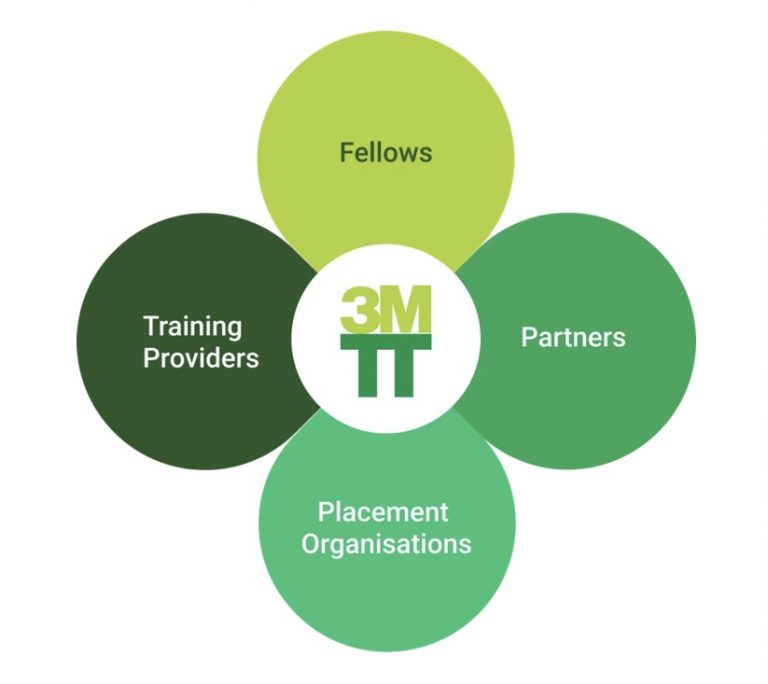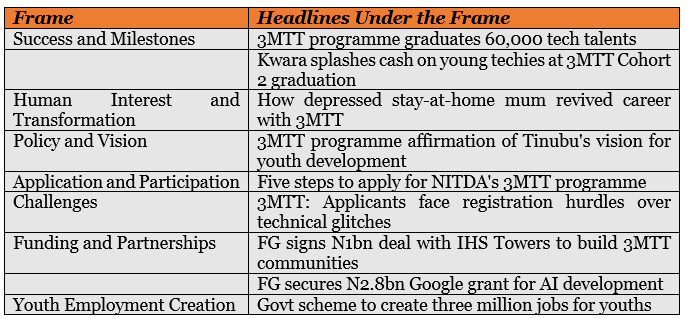
The mediatization framework offers a critical perspective through which to assess the media’s impact on social, political, and economic realities. In this piece, our analyst examines the media headlines around the 3MTT programme, drawing on news published by The Punch. Analysis indicates how its narrative was developed and understood, providing valuable insights into its implementation between 2025 and 2027.
Media Logic and Public Perception
Media logic dictates how information is structured, affecting audience interpretation and shaping public sentiment. The 3MTT programme’s media coverage reflects a blend of celebratory, critical, and procedural narratives. Celebratory headlines, such as “3MTT programme graduates 60,000 tech talents” and “How depressed stay-at-home mum revived career with 3MTT”, showcase the programme’s success stories and human-interest angles. These narratives amplify the programme’s transformative impact on individuals, presenting it as a catalyst for career rejuvenation and societal progress. Similarly, “Govt scheme to create three million jobs for youths” frames 3MTT as a bold intervention against youth unemployment, positioning it as a pillar of national development.
While such celebratory framing builds goodwill and paints the programme as transformative, an over-reliance on positivity risks obscuring the challenges faced. Critical engagement with these limitations is vital to maintaining credibility and fostering balanced discourse. Complementing these are procedural and critical narratives, such as “3MTT: Applicants face registration hurdles over technical glitches”. This headline highlights structural inefficiencies, contrasting sharply with the celebratory tone. Meanwhile, “Five steps to apply for NITDA’s 3MTT programme” caters to potential participants’ informational needs, stressing accessibility. Together, these narratives provide a balanced media portrayal. However, excessive focus on operational glitches could undermine trust, especially if such issues persist unaddressed.
Register for Tekedia Mini-MBA edition 19 (Feb 9 – May 2, 2026): big discounts for early bird.
Tekedia AI in Business Masterclass opens registrations.
Join Tekedia Capital Syndicate and co-invest in great global startups.
Register for Tekedia AI Lab: From Technical Design to Deployment (next edition begins Jan 24 2026).
Institutional Mediatization and Strategic Partnerships
Institutional mediatization explores how entities, such as governments or corporations, adapt to media dynamics to align with public narratives. The 3MTT programme’s strategic partnerships with corporate giants like Google and IHS Towers exemplify this alignment. Headlines such as “FG signs N1bn deal with IHS Towers to build 3MTT communities” and “FG secures N2.8bn Google grant for AI development” emphasize collaborations that lend global legitimacy and underscore the programme’s scalability.
These partnerships bolster the programme’s image as a forward-thinking initiative. However, the sustainability of such media coverage hinges on the tangible benefits these collaborations yield. If results fail to meet expectations, these partnerships risk being perceived as symbolic rather than substantive.
The programme’s integration into political narratives, as seen in “3MTT programme affirmation of Tinubu’s vision for youth development”, underscores its positioning within broader governance strategies. While political association can enhance visibility, it also risks polarizing public opinion. Ensuring bipartisan support will be critical for the programme’s continuity and long-term success beyond 2027.
Media’s Amplification of Structural Challenges
Media coverage has not shied away from highlighting operational challenges within the 3MTT programme. For instance, “3MTT: Applicants face registration hurdles over technical glitches” shines a spotlight on the accessibility issues that marred the registration process. Such narratives are double-edged; while they underscore areas for improvement, they also risk eroding public trust if left unaddressed. To counteract this, the programme must prioritize transparency and actively communicate measures taken to resolve such challenges. Regular updates on improvements can mitigate the impact of negative press and reinforce the narrative of a responsive and adaptive initiative.
The Power of Human-Interest Stories
Human-interest narratives, such as “How depressed stay-at-home mum revived career with 3MTT”, add a relatable and emotional dimension to the programme’s coverage. These stories humanize the initiative, fostering a deeper connection with the public and encouraging participation. By spotlighting diverse participant experiences, the 3MTT programme can reinforce its inclusivity and demonstrate its broad societal impact. Proactive storytelling that highlights a range of demographics will further enhance the programme’s appeal, ensuring it resonates with varied audience segments.
Technology-Centric Framing and Future Relevance
The tech-oriented framing of the 3MTT programme is evident in headlines like “FG secures N2.8bn Google grant for AI development” and “Kwara splashes cash on young techies at 3MTT Cohort 2 graduation”. These narratives position the programme as a cutting-edge initiative aligned with global technological advancements. To maintain relevance, the 3MTT curriculum must continuously evolve to incorporate emerging trends, ensuring participants are equipped with future-ready skills. Expanding beyond a tech-centric focus to include entrepreneurial and creative industries could enhance inclusivity and broaden the programme’s impact.
Exhibit 1: Frames in headlining 3MTT

As Nigeria prepares for the significant implications of the 3 Million Technical Talent (3MTT) programme from 2025 to 2027, several strategic insights emerge from a comprehensive mediatization analysis. There is a need for a balanced media narrative. The programme should diversify its storytelling approach to encompass not only the successes but also the challenges faced and the resolutions implemented. Collaborating closely with journalists and stakeholders will help present an authentic and balanced picture, minimizing an over-reliance on either celebratory or critical extremes. Operational transparency is another critical area of focus. Addressing any technical glitches or administrative issues proactively can preempt negative press coverage. Establishing a robust feedback mechanism will also help in demonstrating accountability and foster continuous improvement for future cohorts.
Moreover, sustained partnerships are essential for reinforcing the program’s credibility. Showcasing the long-term impacts of collaborations with corporations such as Google and IHS Towers will strengthen these relationships. Additionally, exploring partnerships in underrepresented sectors will ensure inclusivity and relevance in an evolving economic landscape. The potential risks of politicization must also be considered. Ensuring bipartisan ownership of the initiative is crucial to safeguarding its continuity beyond 2027. Communication should focus on impact metrics rather than political affiliations to appeal to a broader audience.
An adaptive curriculum is necessary to keep pace with technological advancements. The programme should anticipate shifts in technology and diversify training to include essential skills such as entrepreneurship and creative industries. Monitoring labour market trends will allow for timely adjustments to the curriculum, ensuring that graduates remain employable across various sectors. A human-centric marketing strategy should be employed. Utilizing human-interest stories can effectively demonstrate tangible impacts while ensuring that diverse demographics and career pathways are represented to avoid oversimplification. Empowering graduates to act as ambassadors by sharing their experiences will inspire future participants and enhance the programme’s reach.



